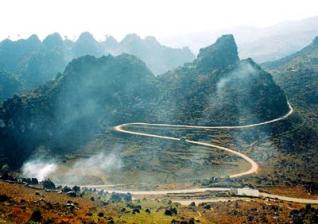Your favorite destinations
| No | Destination |

Dong Van karst plateau has an area of 2.350 square kilometers, spreads over four districts of Ha Giang province: Quan Ba, Yen Minh, Dong Van and Meo Vac at an average height of 1.400 - 1.600 meters with a number of beautiful limestone and winding road. Here, scientists have found 33 tectonics heritages, 45 geomorphology heritages and many unique fossils in sedimentary rock, which creates opportunities for the tourist attraction, brings income for indigenous people.
From Ha Giang town, along 4C Highway about 50 kilometers, tourists step into Quan Ba districts with spectacular and grandeur mountain scenery. In the journey to the rocky plateau, visitors can enjoy the beauty of Can Ty Pass. Dong Van karst plateau has 80% limestone, is one of the most distinctive karst in Vietnam with black and majestic boulders. The shapes of boulders are created by environmental conditions and different stages of development.
Here, the whole scene is rocks with various shapes such as petals, flowers, flower branch (Khau vai rock garden, Veo Vac District) or the shape of tiger (Lung Cu rock garden). Van Chai rock garden has green grass that creates the majestic and grandeur beauty for landscape.
The tectonic activities created canyons in Dong Van Karst Plateau, particularly in limestone area. Among karst canyons in Dong Van, Tu San is the most beautiful and majestic canyon. From Ma Pi Leng Pass beside Tu San Canyon, tourists can observe the wonderful folds of Devonian limestone.
The climate here is divided in two distinct seasons, rainy season (from May to October) and dry season (from November to April). The annual average temperature varies between 24 and 28oC. In winter, the temperature is sometimes down to -5oC. The best time to visit Dong Van is the spring. Tourists are hit by wonderful landscapes composed by yellow cai (kale) flowers and pink peach flowers in full blossom, mossy tiled roofs of stilt houses, dark green rocks and blue skies.
Thanks to weather changes and Dong Van's geo-diversity, the karst evolution has created “rock gardens” and “rock forests” of diverse forms in the area, such as Khau Vai rock garden (Meo Vac) where tourist can contemplate the peaks of rocks in the shape of different kinds of flowers, Lung Pu rock garden (Meo Vac) with animal-shaped rocks such as tiger and dragon, Van Chai rock garden (Dong Van) with round flagstones arranged like thousands of black sea lions leaning one another getting some rest on the beach. However, found commonly here are ranges of mountains running one after another to form pyramids heading up to skies.
A system of caves and grottos found in the Dong Van Plateau provides a proof of the evolution of karst with Rong Cave in Sang Tung (Dong Van), Kho My Cave in Tung Vai (Quan Ba), En Grotto in Van Chai (Dong Van)...
Besides the geological value, Dong Van karst plateau also attracts tourists by the unique cultural and spiritual values associated with the ethnic Mong, Dao, Lo Lo… living on the plateau. They picked up stones to build house, walls. They carved stone to grow corn. They renovated the mountainside into a vast of rice. The beauty and grandeur of Dong Van plateau comes from not only the huge natural boulders but also the fair of the H’mong, Dao, Lo Lo… In the morning, ethnic people from neighbor districts come to fair with colorful costumes.
From the geological unique, in the end of 2010, Dong Van karst plateau was recognized as the first geological park of Vietnam and Geoparks of the world. Dong Van karst plateau is one of the special limestone mountain, including the marks of the history of the earth’s crust process and tradition of indigenous communities.
Dong Van karst plateau has all elements convergence to become global Geoparks. Rocky plateau also has national relic such as: mansion of Vuong family, Lung Cu flag pole, Dong Van ancient, Ma Li Peng pass, Quan Ba Twin Mountain…